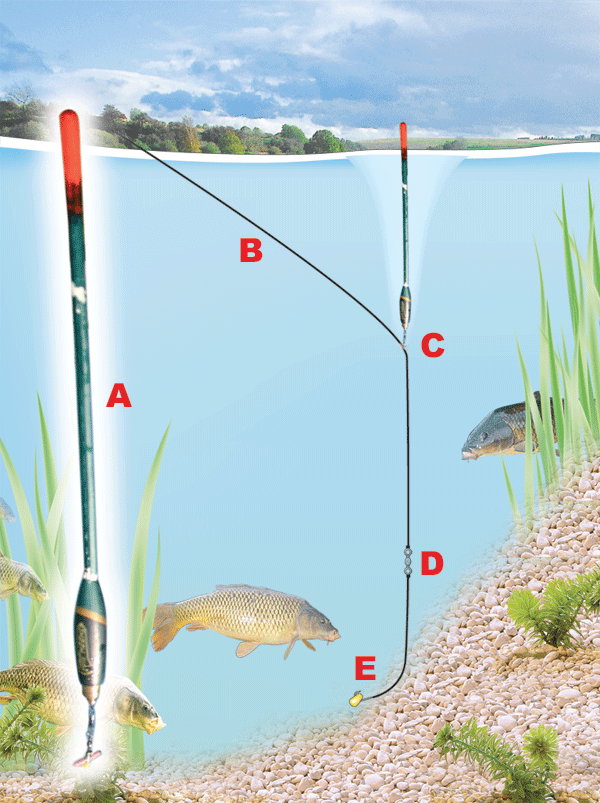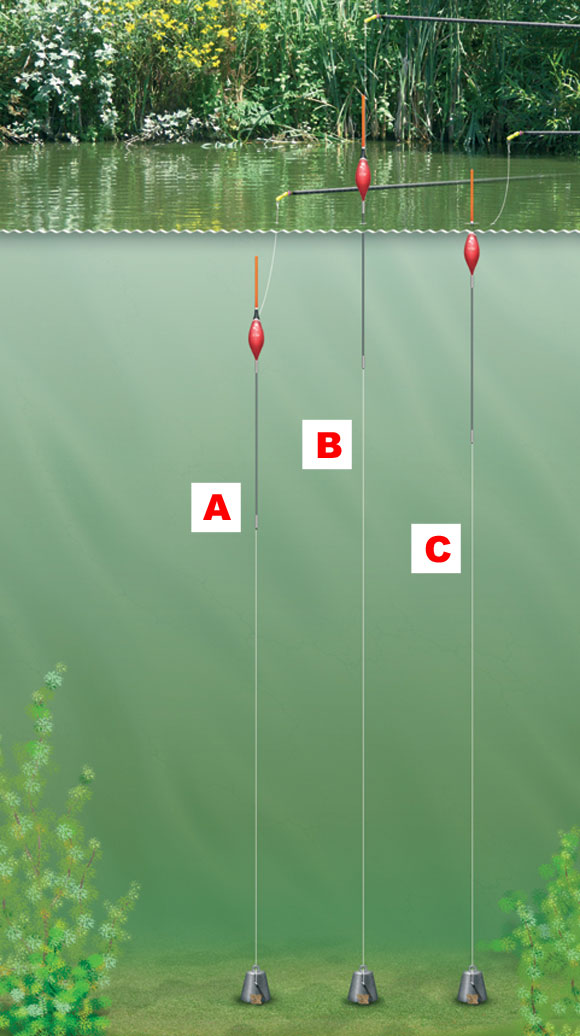Rudd fishing rig | Bread on the float
If there’s one fish species that sums up summer fishing then a big, golden rudd must be it! These stunning fish, with their surface feeding habits, are the epitome of warm-weather angling.
Rudd are famous for taking baits in the upper layers of the water, and they’re adept at picking off small insects which fall into the water from surrounding vegetation.
This makes fishing for them with baits such as casters and slow-falling maggots a great tactic, especially on the float.
However, rudd will take a
big bait too and one of the best is breadflake – a bright bait they can’t fail to miss – and one which is soft and easily sucked in by these rather greedy fish.
Watching big rudd taking floating breadcrust or flake on a sunny day is one of the great sights of summer.
1) Hookbaits
Floating crust or flake is a great starting bait, as it matches your loosefeed, but the fish can become cagey later in the session after you’ve caught a few.
This is when it can pay to use breadflake. Be sure to give the flake a bit of a squeeze so it falls slowly through the upper layers of the water.
2) How far out?
You usually need to fish only a couple of rodlengths out for rudd if you’ve got them feeding properly, but make sure you’ve got enough weight in the float to follow the fish if they spook and move further out.
3) Mainline and hooks
Most anglers will fish ‘straight through’ when rudd fishing to aid presentation of the hookbait, as a knot can easily be seen by the fish in clear water.
Depending on the size of fish, pick a floatfishing line of around 3lb-4lb.
Eyed hooks are usually favoured by specimen rudd anglers, as the extra bit of metal helps when moulding a piece of bread around the hook. Size depends on the size of fish and hookbait but most anglers use between a 10 and 14 for specimen fish.
4) Length of the rig
A 3ft distance between float and bait is a good starting point to help prevent rudd being spooked by the waggler, but be prepared to extend this if the fish do show signs of spooking.
It’s not unheard of to end up using several feet of line in very clear water.
5) Loaded floats
Stealth is the key when fishing for rudd up in the water so a small pellet waggler (normally used for catching carp shallow) or a loaded, clear plastic waggler is perfect for the job. You’re looking for a float that doesn’t dive too deep on the cast, as this will spook the fish.
It’s important to use a loaded float so you don’t need to place shot down the line, as this will constantly drag the hookbait down or back towards the float. Instead of having shot around the base of the float, fix the waggler in place with three float stops – one above the float and two below. This allows you to easily alter the distance between float and hookbait.
Rig for floatfishing close to islands and features
This float rig is ideal when casting tight to an island to catch the carp that patrol around its margins. As you will be casting to a feature you can actually use this rig with the line clipped up because a hooked fish will not be able to swim away from you - it can only swim to the side or towards you.
A Use a loaded, bodied float that is attached to the line with a fixed float adaptor. Alternatively a couple of tiny split shot will suffice. The best float to use is a straight bodied waggler because they pop up to the surface very quickly, ready to detect a bite straight away.
B Mainline needs to be strong enough to cope with carp and the problem of hooked fish reaching any snags. We suggest using no lighter than 4lb.
C Make sure that the depth is plumbed accurately so that the rig is set cotrrectly and that the bait touches the bottom.
D By using a swivel to link the mainline to the hooklength esnures that a replacement hooklength can be attached quickly, and as this rig will be cast a lot of times, the hooklength will not spin up as the bait revolves when it is being drawn back to the bank.
E Ideal hooklengths for this rig need to be 0.14mm and above. The best baits for this style of fishing are either sweetcorn, maggots, casters or a piece of worm.
How to plumb the depth when floatfishing a waggler
Close in
Hold the plummet in one hand and your rod in the other – flex the tip of the rod slightly by pulling the line taught. Open the bail arm of the reel. Swing the rod upwards, let go of the plummet and take your finger off the spool to cast the plummet into the swim. Timing and a smooth motion is crucial, so do it very slowly to begin with to gain practice. Casting the plummet in this fashion minimises the disturbance it causes when it hits the water – but you can cast it overhead just like you would a float if you can’t master this way.
At distance
Pinch an SSG weight onto your hook (inset). Cast it into the swim in an overhead fashion. As long as the SSG is enough to sink your float it will take it out of sight if you are too shallow. When you can only see the fluorescent part of the float, it is set at a dead depth.
A. This shows you are too shallow.
B. This shows you are slightly too deep.
C. This shows you are just on the bottom.
How to find the depth when pole fishing
Plumbing and finding the depth of the lake, canal or river when pole fishing is a lot easier than finding the depth when you're float fishing because you can simply lower the plummet into your swim and gently drop it onto various areas of the swim to gain a true picture of the venue's depth.
It's a vital part to a successful session as it will give you a true picture of what's under the water and therefore give you a great insight into where you should be feeding and placing your bait.
You can also use your plummet to locate any underwater obstacles too by gently 'swinging' the plummet through the swim to see if it becomes lodged against anything that's submerged.
Here's how to go about finding the depth on your pole line...
STEP 1
Pass your hook through the eye in the plummet
STEP 2
Secure your hook into the cork in the base of the plummet.
STEP 3
Lower the plummet into the swim below the end of your pole.
STEP 4
Add a section of pole at a time and plumb around the swim, lowering the plummet straight down, not at an angle, to ensure an accurate reading of the swim.
STEP 5
Once you have got the exact depth of the swim, hook your hook into the base of your pole top kit. This will pull the elastic out slightly and secure your rig. With Tipp-Ex, mark the point where the top and the bottom of your float sit against the pole. This means you always have a point to refer back to should you change the depth you are fishing during the day.
A. This shows the float is set too shallow
B. This shows the float is set too deep
C. This shows the float is set perfect
How and when to use a Driftbeater float rig
Want to be able to keep your float rig still when fishing a large windswept lake? Well here’s the rig for you – the simple driftbeater rig. When fished correctly this rig can be used to anchor your bait to the bottom in the strongest of undertows.
It works by placing a fairly large shot overdepth, so that it rests on the bottom. This helps hold the rig in place far better than a standard waggler rig fished overdepth ever would.
Driftbeater floats are a little specialised items of fishing tackle so not all tackle shops sell them, unfortunately. They are a bodied waggler having a very long and slender stem that leads to a bulbous balsa sight tip. No other float looks like a driftbeater.
You will need to plumb the depth accurately when using a driftbeater rig, as you have to place a shot far enough down the line so it rests on the bottom.
Here’s how to make the rig:
A Shot the float so that only the body is submerged. Don’t worry that there is 8ins of the stem sticking out the water – you’ll rectify this when you are fishing with the rig properly.
B Your mainline will need to match the species you are catching. A good starting point will be around the 3-4lb mark. Also, sinking mainlines are better as the line will cut through the surface tension and sink, preventing it from being pulled across the water surface in the wind.
C Find the depth of the swim using a plummet, then add another 12ins to the length of the rig. Now place a substantial split shot 8ins from the hook. A No1, or in extreme conditions a BB shot, would be ideal.
D After casting, allow the bottom-most shot to settle on the bottom, then sink your rod tip and wind it a few turns to sink the line between rod and float. Place your rod in rests with the rod tip submerged and slowly turn the reel’s handle until the float sinks to its sight tip. It is now ready to register a bite. Although there are times when the float will be instantly pulled under, most bites will lift the float right out the water.
E Remember to use a hook to match the size of the bait you are fishing with.





